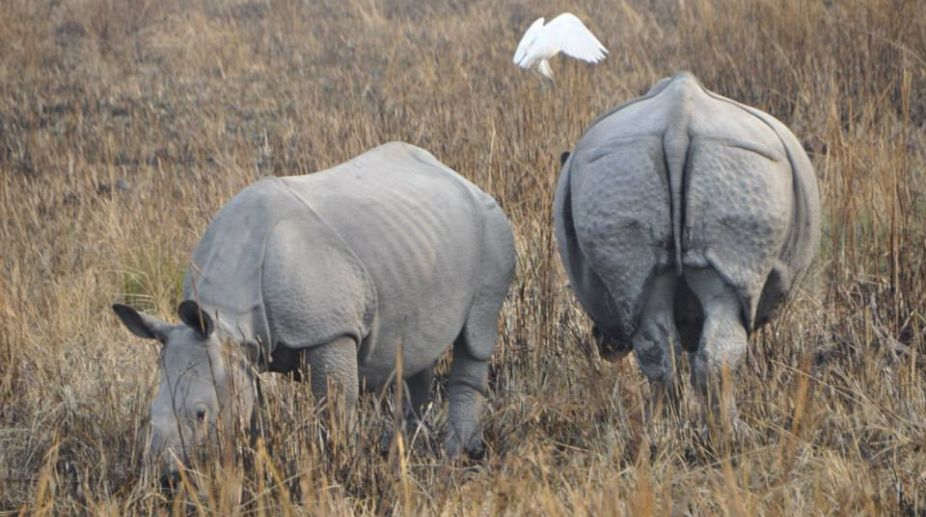Rhinos in Asia are critically endangered. If one studies the status of the Greater One Horned (or Indian) Rhino, it will reveal that conservation measures have, to an extent, helped this species in Assam’s Kaziranga National Park — their status has now changed from “endangered” to “vulnerable”.
The authorities at Kaziranga conducted its12th Rhino population estimation exercise in March 2015. The committee was headed by C Muthu Kumarvel, IFS, divisional forest officer, Golaghat Division. The rhino population in Kaziranga and adjoining areas has been estimated at 2,401. But there is no place for complacency, as the spectre of poaching still looms over this animal, which is persecuted for its horn. If one moves their gaze to Africa, a survey reveals there were an estimated 65,000 black rhinos in sub-Saharan Africa but about 90 per cent of them were killed in the 1970s. There are fewer than 2,500 left in pockets of Zimbabwe, South Africa, Kenya and Tanzania. Incredibly, our study now shifts to the US, where an unexpected visitor arrived at a location in America, and whose activity provided thought-provoking analyses to wildlife experts around the world. From the US this melodrama zooms into Paris, Ireland and Vietnam. But these countries are not known for keeping thousands of rhinos, are they? The rhino’s saga unfolds in this extraordinary tale.

The University of Vermont, US, has a famous 130-year-old wing called the Torrey Hall. In that time Torrey Hall served the university with its first library and museum — the building was named after Joseph Torrey, a professor and the university’s ninth president. In 1824, the building encountered a fire, which consumed the library and destroyed a repository of books.
Torrey travelled to Europe, to procure books for the library, and returned with 7,000 volumes. In 1862, a new library was built and was named in Torrey’s honour. After serving the University of Vermont, for nearly a century, Torrey Hall went through major renovations, in 1974 and some changes were made. The Pringle Herbarium was moved to Torrey Hall and the Hall is also home to the Thompson Natural History Collection, where, among scores of specimens, is displayed a black rhino horn, which has been in the custody of the university for many decades. An episode occurred, which also found its way into the university’s history.
On 27 April this year, a thief entered the University of Vermont, disabled a lock and went inside Torrey Hall, from where he went like a “homing pigeon” to the Thompson’s Natural History Collection, grabbed the black rhino horn, and disappeared. Wilson Ring, of the Associated Press, reported that the burglar had stolen the horn with the sole intention of selling it in the black market, where it could be worth a million dollars. Ring writes, “It’s obviously very, very, valuable, if it makes its way into Asia.” The university is offering a reward of three thousand dollars for the horn’s return and records state that the horn was received by the university sometime in the early 1900s. This could translate into a disturbing new trend because rhino horn poachers have begun to target rhino horns outside Africa or India.
In March 2017, poachers killed a black rhino in a zoo near Paris by shooting it and then with the aid of a chainsaw sawed off the horn. A month later, a gang of thieves based in Ireland, went on trial for stealing up to 80 rhino horns from museums across Europe. Karen Brulliard, of The Washington Post, writes, “Prices for rhino horns have increased almost thirty times and a full horn can sell for more than one million dollars.”
But Gwynn Guilford’s report in The Atlantic is interesting because Guilford writes of a rumour in Vietnam — it goes that powdered rhino horn could cure cancer. Statistics, however, did reveal that from 1990 to 2007, rhino poaching declined due to traditional Chinese medicine replacing rhino horn powder. But the powder curing cancer and its efficacy as an aphrodisiac, has increased poaching of rhinos again.
Bill Kirkpatrick, a professor at the University of Vermont, says that samples in a university help research but data can be lost forever, if a sample, like the one at Torrey Hall, is stolen. The rhino’s saga has reflected humanity’s mindless slaughter of animals and birds, many of which have declined over the decades.
Charles Darwin wrote on the prerequisites needed to keep animals and creatures of the earth multiplying on the planet, “The vigorous, the healthy, and the happy survive and multiply.” Tragically, those vigorous and healthy animals cannot compete with guns and traps of poachers who can go to any extent for a rhino horn.












